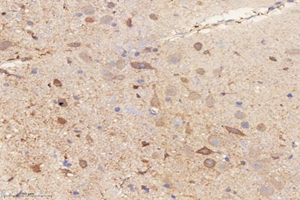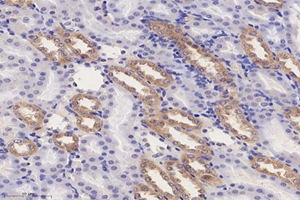| Reactivity: | R |
| Applications: | IHC |
| Host Species: | Rabbit |
| Clonality: | Polyclonal |
| Full Name: | CLC7 rabbit polyclonal |
Gene Name: | H(+)/Cl(-) exchange transporter 7 |
Synonyms: | Chloride channel 7 alpha subunit, Chloride channel protein 7, ClC-7, Clcn7, Clc7, OPTA2, OPTB4 |
Immunogen: | KLH conjugated Synthetic peptide corresponding to Mouse CLC7 |
Isotype: | IgG |
Purity: | Affinity purification |
Subcellular location: | Lysosome |
Uniprot ID: |
Product Usage Information
Applications | Species | Dilution | Positive tissue |
IHC | Rat | 1: 1400-1: 2800 | kidney, brain |
Background
The product of this gene belongs to the CLC chloride channel family of proteins. Chloride channels play important roles in the plasma membrane and in intracellular organelles. This gene encodes chloride channel 7. Defects in this gene are the cause of osteopetrosis autosomal recessive type 4 (OPTB4), also called infantile malignant osteopetrosis type 2 as well as the cause of autosomal dominant osteopetrosis type 2 (OPTA2), also called autosomal dominant Albers-Schonberg disease or marble disease autosoml dominant. Osteopetrosis is a rare genetic disease characterized by abnormally dense bone, due to defective resorption of immature bone. OPTA2 is the most common form of osteopetrosis, occurring in adolescence or adulthood.
Images
| Immunohistochemistry analysis of paraffin-embedded rat brain using CLC7 (GB113266) at dilution of 1: 2800 |
| Immunohistochemistry analysis of paraffin-embedded rat kidney using CLC7 (GB113266) at dilution of 1: 2800 |
Storage
| Storage | Store at -20°C for one year. Avoid repeated freeze/thaw cycles. |
| Storage Buffer | PBS with 0.02%sodium azide,100 μg/ml BSA and 50% glycerol. |


